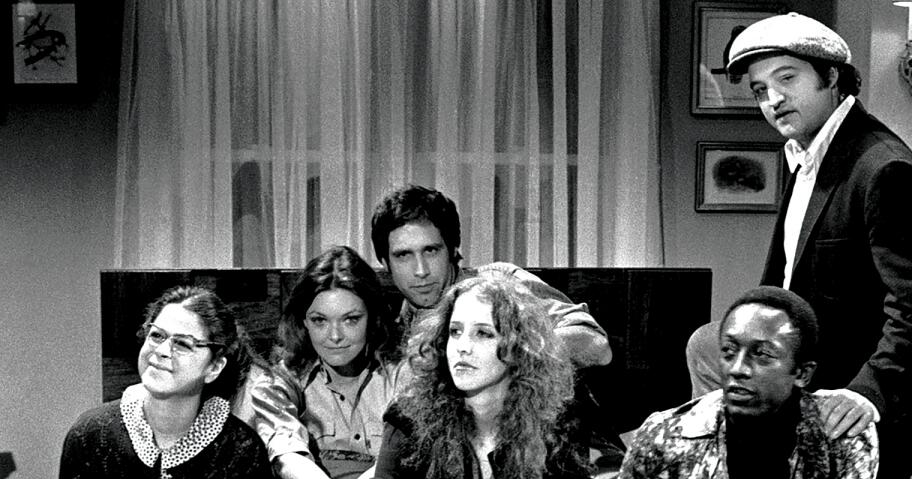“Saturday Night Live” is having a 50th anniversary, and things are happening.
Jason Reitman’s backstage dramedy “Saturday Night,” released last year, is set around the series’ first episode. There is a profile of executive producer Lorne Michaels in the New Yorker this week, taken from Susan Morrison’s upcoming biography, “Lorne: The Man Who Invented Saturday Night.” Peacock, NBC’s streaming arm, has an engaging docuseries, “SNL50: Beyond Saturday Night,” now streaming, its standalone episodes focused respectively on auditions (“Five Minutes”), the creative system (“Written By: A Week Inside the SNL Writers Room”), an iconic sketch (“More Cowbell”) and when Michaels returned to run the show after a five-year break (“Season 11: The Weird Year”).
Premiering Jan. 27 on NBC, “Ladies & Gentlemen … 50 Years of SNL Music,” co-directed by Questlove and Oz Rodriguez, looks at the show’s rich history of musical performances, musicians doing comedy and comedians doing music; it opens with a long, artful mash-up/medley of performances that makes one glad to have been alive in its time, and just glad to be alive. And on Feb. 16, NBC will air and Peacock will stream “SNL50: The Anniversary Special,” a three-hour prime-time event. It’ll be live, naturally.
Much about the show, which has been analyzed and reported on for half a century, is obvious. It isn’t always good — practically (or entirely) never through a whole episode, and some would say a whole season. It survives by constant churn. Counted out more than once, it has risen from the mat to fight again, new wins erasing old losses — a once and future champ.
Over time, it has become something more than a show — a network, a world. Favorite guest hosts and musical guests return again and again, defining “SNL” as much as the regular cast or writers. The cold open for the 2024 Christmas episode, hosted by Martin Short — a cast member in Season 10 — revisited the premise of the “Five-Timers Club,” whose members have hosted (at least) five times, and featured cameos from Tom Hanks, Paul Rudd, John Mulaney, Emma Stone, Tina Fey, Kristen Wiig, Scarlett Johansson, Melissa McCarthy, Alec Baldwin and Jimmy Fallon. (There are more in that club, including Dwayne Johnson, Justin Timberlake, Candice Bergen and Christopher Walken, who played the record producer who called for “more cowbell.”)

Whipped up out of nothing over six days (on the seventh they rest), “SNL” is unavoidably imperfect. Sketches go on too long. Jokes fall flat. Some hosts, especially those from outside show business, do not do well. At the same time, the show, even though it is revised until the last minute, is tightly organized, a machine involving scores of workers creating sets and wrangling costumes in the last couple of days before air. (Writers are responsible for directing their sketches.) There is little to no improvisation. The system, which seems to have remained substantially the same over the years, is arranged to mitigate failure, but failure is part of the process, as ideas are rejected and sketches cut. And what works in dress may not work on air.
In the beginning, television was live by technological necessity; by 1975, it was strictly for sports and news and special events. “SNL,” which was created to replace reruns of Johnny Carson’s “Tonight Show,” called back to the spirit of Sid Caesar’s 1950s “Your Show of Shows,” but delivered its version of variety with a countercultural, youth-directed spin. (Caesar was still considered groundbreaking. A compilation of sketches, “Ten From Your Show of Shows,” captured on kinescope, had been released in theaters in 1973; he would host “SNL” in 1983.) It was live not because it had to be, but because “live” was exciting and dangerous, and, by the standards of network television, raw; it courted disaster, and sometimes disaster won.
It also bound the audience, participating in real time (on the East Coast, anyway), to the event and to the players. That compact first cast, the Not Ready for Prime Time Players — Gilda Radner, Laraine Newman, Jane Curtin, Garrett Morris, Dan Aykroyd, John Belushi and Chevy Chase, replaced in the second season by Bill Murray — was covered like a rock band (the rock press having little use for the rest of television), and consumed like one. Producer Michaels played himself, as a character.
 Dan Aykroyd, left, and Lorne Michaels, the creator and producer of “SNL.”
Dan Aykroyd, left, and Lorne Michaels, the creator and producer of “SNL.”
Looking back, the series did get off to a rough start but came into focus fairly quickly. Early classics include Radner’s “The Judy Miller Show, Live From Her Bedroom,” Aykroyd’s self-destroying Julia Child, an aged Belushi visiting the Not Ready for Prime Time cemetery as the only surviving cast member, Chase and host Richard Pryor in an escalating, racially charged word association test. Anything with Murray feels oddly contemporary, so strong an impression has he made on the culture, and so fully formed was his persona from the beginning. But not all humor travels well. (Curtin looking back from 2023 at an old episode, told People magazine that “not one thing was funny.”) Two sketches that have stayed with me from that era, are not really comedy at all — the recurring “Olympia Restaurant,” whose only “jokes” are the repetition of the word “cheeseburger” and the phrase, “No Coke, Pepsi,” and the downbeat “Reunion,” a two-hander for Aykroyd and Curtin as two former high school classmates seated accidentally next to one another at a lunch counter. These are theater pieces, really, from the show’s experimental youth, and they’ve stayed fresh.
Those first seasons are ancient history, of course; the original cast are in their 70s or 80s, or have passed on. Fifty years before “SNL,” movies still had two years to wait before they could talk; Charlie Chaplin’s “The Gold Rush,” Buster Keaton’s “Go West” and Harold Lloyd’s “The Freshman” were released; “The Great Gatsby” was published; the Scopes “Monkey Trial” took place; the Mount Rushmore memorial was dedicated; and the world’s first motel opened. It’s a much repeated commonplace that one’s favorite “SNL” cast is the one you meet in high school (which does suggest there is something adolescent in its humor), and most everyone in the cast today grew up on the 21st century series. “Never mind,” “Generalissimo Francisco Franco is still dead,” “Consume mass quantities,” “But nooooo!,” even the “Wayne’s World” cry “We’re not worthy!” — these catch phrases will ring no bells with younger viewers.

“We’re not worthy!”: Mike Myers, left, as Wayne and Dana Carvey as Garth in a “Wayne’s World” skit. (Alan Singer/NBCU)

The ladies of “Weekend Update”: Tina Fey, left, and Amy Poehler. (Dana Edelson/NBC)
It’s an institution, a frame in which to be displayed, a portal to pass through on the way to bigger things, or different things, or lesser things. Some players last a long while, some a little while; some leave of their own accord, some are shown the door. “SNL” is not the only hub of modern American comedy, or the only path to success. But in terms of exposure, there’s nothing like it. At rare times, known properties have joined the cast — Kenan Thompson, on the show for an unmatched 22 seasons and counting, had already starred in a name-in-the-title Nickelodeon series “Kenan & Kel” and its successful film spinoff “Good Burger.” But more often “SNL” is where careers take off.
Eddie Murphy, Phil Hartman, Amy Poehler and Tina Fey (establishing their double act anchoring “Weekend Update”), Melissa McCarthy, Tracy Morgan, Maya Rudolph, Julia Louis-Dreyfus, Jon Lovitz, Chris Rock, Dana Carvey, Mike Myers, Adam Sandler, Andy Samberg, Chris Farley, David Spade, Tim Meadows, Leslie Jones, Norm Macdonald, Will Ferrell, Molly Shannon, Fred Armisen, Kristen Wiig, Bill Hader, Jason Sudeikis, Julia Sweeney and Bobby Moynihan number among its longer-serving alumni. Through Fallon and Seth Meyers, the show has colonized weeknight late-night television. (Both their shows are produced by Michaels’ Broadway Video.) Stephen Colbert auditioned for “SNL” — a clip of his audition is included in “Five Minutes” — and was turned down. Things worked out for him anyway.
The world has come far since 1975, and “SNL” has left a little garbage in its wake. Notably, the show has been slow to evolve in matters of diversity. White cast would often play non-white cast, such as Billy Crystal’s blackface (if affectionate) Sammy Davis Jr. It’s a far cry from the days when Morris was required to play every Black character, male or female, but it was already 2013 when Thompson refused to portray Black women and demanded the show hire actual Black women instead. Bowen Yang, who is of Chinese descent, was named to the repertory cast in 2019, making him the first “full-blooded” Asian cast member.
Bowen Yang in a Season 49 sketch. He was “SNL’s” first Asian cast member. (NBC/Lauren Clements/NBC)
Kenan Thompson as Little Richard last year. He’s the longest-tenured “SNL” cast member. (Will Heath/NBC)
I can’t say I consume it whole anymore, at the time of broadcast or by DVR, though seemingly people do — 4 or 5 million or more, to reckon by Nielsen’s Live + First Day ratings. It’s not my “SNL” now, which is not meant as a criticism, only an admission. But the show’s practice of repeating sketches and characters means one can get a fairly good idea of what it’s up to just dropping by. YouTube clips — there are 15 million subscribers to the “Saturday Night Live” channel — and social media sharing, which I thank for guiding me to Nate Bargatze in “Washington’s Dream,” can keep one abreast of the latest development.
And at 50, it looks pretty good. (I have been checking in, in the anniversary spirit.) A few younger players in the current cast make an amorphous impression, but the ranks of the veterans are strong: Thompson, who has been with the series nearly half its life, and at 46, nearly half his; Mikey Day (44); Heidi Gardner (41); Bowen Yang (34); Chloe Fineman (36); Ego Nwodim (36); Michael Che (41) and Colin Jost (42), anchoring Weekend Update for more than a decade. (In a cast with 15 “repertory players,” and three “featured players,” they stand out just by virtue of having been around longer.) And some of those younger players will go on to become older players as new younger players move in behind them, and so turns the circle of life.
You don’t have to look far to find viewers declaring the show to be Not as Funny as It Used To Be. That’s a common enough complaint when it comes to comedy. By changing with the changing times, but not changing so much as to lose itself, “Saturday Night Live” has survived everything the last 50 years have thrown at it, at us, charting a path between the slightly left of mainstream and the more than slightly left of mainstream, between familiarity and surprise. What it offers, Saturday after Saturday, is possibility. What might go right? What could go wrong?







